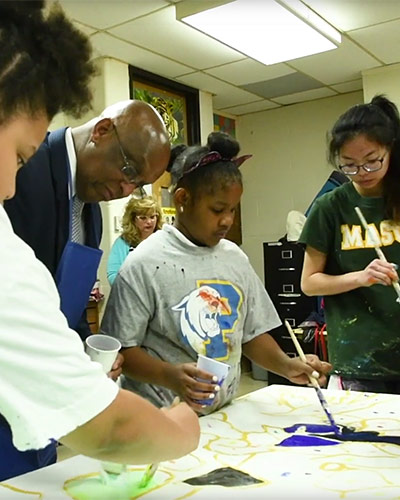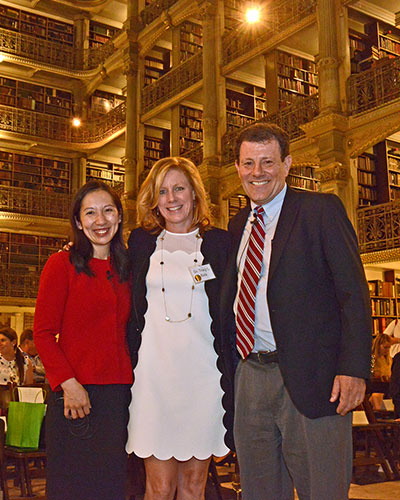September 19, 2019
Students art was used to create a giant mural about what they learned.
 A giant mural with images depicting reading and the brain was unveiled during a ribbon cutting ceremony at Baltimore's Callaway Elementary School. It was part of Reading on the Brain, a University of Maryland School of Medicine (UMSOM) program to teach young students about the importance of reading and how reading can stimulate brain development and inspire future success.
A giant mural with images depicting reading and the brain was unveiled during a ribbon cutting ceremony at Baltimore's Callaway Elementary School. It was part of Reading on the Brain, a University of Maryland School of Medicine (UMSOM) program to teach young students about the importance of reading and how reading can stimulate brain development and inspire future success.
The mural was created over several months with the help of acclaimed Baltimore artist Jay Wolf Schlossberg-Cohen, who worked with students twice a week to translate scientific concepts about reading and the brain into a unique work of art. The student’s paintings depicted neurons, astrocytes and visions of what they think happens to the brain when they read. The mural is 1,800 square feet and adorns the front wall of Callaway Elementary.
Tracy Bale, PhD, is leading the pilot program, which emphasizes science in helping children to understand how the brain works. Professor Bale is Director of the UMSOM Center for the Epigenetic Research in Child Health and Brain Development (CERCH). The Center's mission is to facilitate translational research and community engagement important in child health and brain development. Studies using brain imaging have shown that reading stimulates mental imagery, language processing, and brain activity in regions important for mental health and stress relief.
 "The idea behind this program was to inspire the community to think about the impact and importance of a child's brain, the influences of the environment, and the amazing potential and benefits of reading," said Dr. Bale during a ceremony attended by the student artists, UMSOM Dean E. Abert Reece, MD, PhD, MBA, and Baltimore Public Schools CEO Dr. Sonja Brookins Santelises.
"The idea behind this program was to inspire the community to think about the impact and importance of a child's brain, the influences of the environment, and the amazing potential and benefits of reading," said Dr. Bale during a ceremony attended by the student artists, UMSOM Dean E. Abert Reece, MD, PhD, MBA, and Baltimore Public Schools CEO Dr. Sonja Brookins Santelises.
Dr. Santelises says the collaboration is making a difference for students. "Part of our whole child initiative is really represented in this work, that you are not just a scientist, but you can also be an artist, a writer and an author," she said.
Dean Reece urged the student artists to “dream big,” and consider medicine as a future career.
BGE donated $5,000 to the Reading on the Brain Program to support its school-based activities.
Support Reading on the Brain and The Center for Epigenetic Research in Child Health and Brain Development (CERCH) at the University of Maryland School of Medicine.
About the University of Maryland School of Medicine
Now in its third century, the University of Maryland School of Medicine was chartered in 1807 as the first public medical school in the United States. It continues today as one of the fastest growing, top-tier biomedical research enterprises in the world -- with 43 academic departments, centers, institutes, and programs; and a faculty of more than 3,000 physicians, scientists, and allied health professionals, including members of the National Academy of Medicine and the National Academy of Sciences, and a distinguished recipient of the Albert E. Lasker Award in Medical Research. With an operating budget of more than $1 billion, the School of Medicine works closely in partnership with the University of Maryland Medical Center and Medical System to provide research-intensive, academic and clinically based care for more than 1.2 million patients each year. The School has over 2,500 students, residents, and fellows, and more than $530 million in extramural funding, with most of its academic departments highly ranked among all medical schools in the nation in research funding. As one of the seven professional schools that make up the University of Maryland, Baltimore campus, the School of Medicine has a total workforce of nearly 7,000 individuals. The combined School and Medical System (“University of Maryland Medicine”) has an annual budget of nearly $6 billion and an economic impact more than $15 billion on the state and local community. The School of Medicine faculty, which ranks as the 8th highest among public medical schools in research productivity, is an innovator in translational medicine, with 600 active patents and 24 start-up companies. The School works locally, nationally, and globally, with research and treatment facilities in 36 countries around the world. Visit medschool.umaryland.edu
Contact
Office of Public Affairs
655 West Baltimore Street
Bressler Research Building 14-002
Baltimore, Maryland 21201-1559
Contact Media Relations
(410) 706-5260
Related stories

Thursday, January 27, 2022
Microbiome of Mother’s Vagina May Affect Infant Mortality Risk and Baby’s Development
A new study in mice from University of Maryland School of Medicine researchers showed that an unhealthy vaginal microbiome in pregnant mothers in combination with an unhealthy diet contributed to increased pup deaths and altered development in the surviving babies.

Wednesday, May 05, 2021
Three Leading UMSOM Faculty Named Among Maryland's Top 100 Women
The Maryland Daily Record has named three leading faculty members at the University of Maryland School of Medicine to its 2021 listing of Maryland’s Top 100 Women. The three-- Tracy L. Bale, PhD, Professor of Pharmacology; Kimberly Lumpkins, MD, MBA, Associate Professor of Surgery; and Jill RachBeisel, MD, the Dr. Irving J. Taylor Professor and Chair of Psychiatry—were chosen for their “outstanding achievements demonstrated through professional accomplishments, community leadership and mentoring,” according to the publication.

Monday, April 29, 2019
UMSOM’s Reading on the Brain Program Teaches Baltimore City Elementary Students About the Brain-Building Power of Reading
Acting Baltimore City Mayor Jack Young joined 4th and 5th grade students at Callaway Elementary School to help paint a mural about the brain. It was all part of Reading on the Brain, a University of Maryland School of Medicine (UMSOM) program to teach young students about the importance of reading and how reading can stimulate brain development and inspire future success. Tracy Bale, PhD, is leading the pilot program, which also emphasizes science and helps children to understand how the brain works.

Monday, July 16, 2018
Microbes from Birth Canal May Affect Stress Levels of Offspring
Researchers have long known that stress during pregnancy may be transferred from the mother to her offspring. Many studies have shown that this stress can have long-lasting impacts on the physical and emotional health of the offspring. However, the mechanisms of this transfer have remained mysterious. A new study has unraveled one possible way in which these effects move from mother to child.

Wednesday, July 11, 2018
Scientists Identify Mechanism That May Explain Why Males Have a Higher Risk for Neurodevelopmental Disorders
Researchers have recently begun to realize that biological sex plays a key role in disease risk. Sex differences play a role in hypertension, diabetes, arthritis – and in many neurological and psychiatric disorders. Depression and anxiety affect females more, while neurodevelopmental disorders, including autism spectrum disorders, early onset schizophrenia, and attention deficit hyperactivity, affect more males. Males are also more sensitive to issues during pregnancy, such as maternal stress, maternal infection and exposure to drugs.

Thursday, May 03, 2018
Renowned Journalist Nicholas Kristof Speaks on Justice and Society
Renowned New York Times journalist Nicholas Kristof will speak on May 3 at the Peabody Library in Baltimore on the need to build a fairer society.

Thursday, March 01, 2018
Increased Stress on Fathers Leads to Brain Development Changes in Offspring
New research in mice has found that a father’s stress affects the brain development of his offspring. This stress changes the father’s sperm, which can then alter the brain development of the child. This new research provides a much better understanding of the key role that fathers play in the brain development of offspring.










